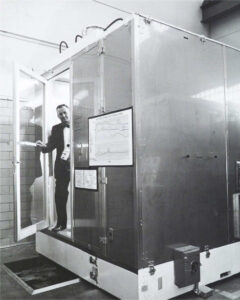Cleanroom History
An Abbreviated Cleanroom History
Cleanroom History

History of Cleanrooms – Attribution-NonCommercial–NoDerivs (CC BY-NC-ND 2.0).
Cleanrooms have a relatively short but interesting history that dates back to the mid-20th century. The concept of cleanrooms was initially developed in the aerospace industry to provide a highly controlled environment for the manufacturing and assembly of spacecraft components.
The first cleanroom was built in 1962 by the American company Sandia Corporation. The facility was designed to provide a controlled environment for the assembly of sensitive satellite components. It featured a highly advanced filtration system that could remove 99.97% of airborne particles measuring 0.3 micrometers or larger.
The modern cleanroom was invented in 1962 at the Sandia National Laboratories by American physicist Willis Whitfield to solve problems of dust particles causing reliability and quality issues with nuclear weapon components. His solution was to constantly flush out the room with highly filtered air. Whitfield’s design made it possible to standardize cleanrooms across the government and its research divisions. Cleanrooms have been instrumental in the research, development, and manufacture of much of our current technology.
During the 1960s and 1970s, the use of cleanrooms became increasingly popular in industries such as microelectronics, pharmaceuticals, and biotechnology. The rapid development of microelectronics, in particular, drove the need for highly controlled environments to manufacture semiconductors and other electronic components. The manufacturing of pharmaceuticals and medical devices also required highly sterile environments to ensure product safety and efficacy.
In the 1980s, the International Organization for Standardization (ISO) developed standards for cleanroom design and operation. These standards provided a framework for ensuring that cleanrooms met specific requirements for air cleanliness, air changes, temperature, and humidity.
Today, cleanrooms are used in a wide range of industries, including electronics, biotechnology, pharmaceuticals, and healthcare. They are essential for manufacturing products that require a highly controlled environment to ensure product quality and safety. Cleanrooms are also critical for research and development activities that require a controlled environment to prevent contamination and ensure accurate results.
Image Source: Sandia National Laboratories
https://www.flickr.com/photos/sandialabs/8203002591/in/set-72157632057328545